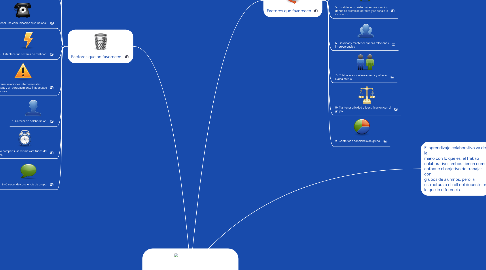
1. Factores que favorecen
1.1. 1- Contar con metas comunes.
1.2. 2- Contar con una organizacion claramente definida en la que se aclaren, METAS, PROCEDIMIENTOS Y FUNCIONES.
1.3. 3- Contar con roles y tareas aceptadas.
1.4. 4- Mantener una comunicacion clara y fluida.
1.5. 5- Establecer un sistema de colaboracion donde se premie lo corecto y se señale lo incorecto.
1.6. 6- Cordinar y mantener buenas relaciones interpersonales.
1.7. 7- Colaborar espontaneamente y ofrecer ayuda mutua.
1.8. 8- Mantener afinidad e identificacion con el grupo.
1.9. 9- Contar con conciencia de grupo.
2. Factores que no favorecen.
2.1. 1- Contar con metas incompatibles.
2.1.1. Situational Analysis / Drivers
2.1.1.1. What is driving us to do this?
2.1.1.2. SWOT Analysis
2.1.1.2.1. Strengths
2.1.1.2.2. Weaknesses
2.1.1.2.3. Opportunities
2.1.1.2.4. Threats
2.1.1.3. Customer Findings - What have we learned from customers?
2.1.2. Competitive Analysis
2.1.2.1. Do we have competitors and threats in these target markets with the proposed offerings?
2.1.2.2. What are our competitors doing and how are they positioning?
2.1.2.3. How do we position against each competitor?
2.1.3. Target Customer(s)
2.1.3.1. Buyer Profile
2.1.3.1.1. Title
2.1.3.1.2. Industry
2.1.3.1.3. Geography
2.1.3.1.4. Business Size
2.1.3.2. Influencer Profile
2.1.3.3. User Profile
2.1.3.4. What do customers want and need?
2.1.3.5. What business problems do each of these customers have?
2.1.4. Customer Segmentation
2.1.4.1. Which customers or sets of customers do we sell to?
2.1.4.2. What are the target market segments that we want to go after?
2.1.4.3. What are the distinct problems for each segment of the market?
2.1.5. Total Available Market
2.1.5.1. New Prospects
2.1.5.1.1. How much of each target segment have we penetrated?
2.1.5.1.2. How much opportunity is available in each target segment?
2.1.5.2. Existing Customers
2.1.5.2.1. Can we up-sell existing customers?
2.2. 2- Ausencia de roles, procedimientos y metas.
2.2.1. Service Offer
2.2.1.1. What are we selling?
2.2.1.2. Product Definition
2.2.1.3. Pricing
2.2.1.4. Packaging
2.2.1.5. Positioning
2.2.2. Value Proposition
2.2.2.1. What is the Value Proposition to the Customer?
2.2.2.2. What pain are we solving?
2.3. 3- Falta de aceptacion de roles e incumplimiento de tareas.
2.3.1. Revenue Forecasts
2.3.1.1. Revenue and P&L Forecast (5 Years)
2.3.1.2. Revenue should be split out quarterly
2.3.2. Cost Analysis
2.3.2.1. Should include a description of the costs in entering this business and profitability analysis
2.3.3. Profitability Analysis
2.3.3.1. P&L for the offer to include gross margin, net income and break even analysis.
2.4. 4- Mantener una comunicacion disfuncional.
2.4.1. Positioning & Messaging
2.4.1.1. What is the key messaging and positioning for the service offer? (Pain, alternatives, solution)
2.4.1.2. How do we communicate internally?
2.4.1.3. How do we communicate externally?
2.4.2. Promotion Strategy
2.4.2.1. Marketing Programs (Installed base versus new prospects)
2.4.2.2. Advertising (Publications, etc.)
2.4.2.3. Analyst Relations (Target Analysts)
2.4.2.4. Public Relations
2.4.2.5. Events (Trade shows, SEO/SEA, Seminars)
2.4.2.6. Webinars
2.4.3. Demand Generation & Lead Qualification
2.4.3.1. How do we generate and qualify new leads for the target offer?
2.4.3.2. Prospect Lists
2.4.3.3. Key Questions to Ask
2.4.3.4. Sales Collateral
2.4.3.5. Presentations
2.4.3.6. Data Sheets
2.4.3.7. White Papers
2.4.3.8. ROI Tools
2.4.3.9. Other Sales Tools (web site, etc.)
2.5. 5- Establecer un sistema de rivalidad.
2.5.1. Numbers, budget, waterfall, break-even (cost>leads>trials>deals)
2.5.2. Sales Programs
2.5.3. Accelerated Learning Strategy, Controls, Metrics
2.5.4. Include feedback loops
2.5.5. Include financial metrics (definition of success)
2.5.6. Pipeline reports, etc…
2.6. 6-Mantener relaciones interpersonales adecuadas y un agrupacmiento inadecuado de personas.
2.6.1. M&A?
2.6.2. Risk Analysis & Mitigation
2.7. 7- Carecer de colaboracion.
2.8. 8- No compartir las mismas actitudes del grupo.
2.9. 9- Carecer de conciencia de grupo.
3. El aprendizaje colaborativo va de la mano con lo que es, el trabao colaborativo, ambos tienen como enfoque el objetivo de trabajar con grupos de alumnos, pero la estructura o el roll del docente es lo que lo diferencia.
3.1. Factores
3.2. que favoren, y
3.3. que no favorecen
3.4. al aprendizaje colaboratibo en los
3.5. entornos virtuales de aprendizaje
3.5.1. Training
3.5.2. Channels
3.5.3. International
3.5.4. Public Sector
3.5.5. Sales
3.5.6. Marketing Communications
3.5.7. Product Management

